AI ethics serves as a compass for integrity in technological innovation. It inspires business leaders to ensure that technological advances benefit society, respect human rights, and prevent the use of AI for harmful purposes.

This places responsibility on leaders to promote ethical behavior.
Challenges in Ethical AI Deployment
Fairness and discrimination
AI needs to ensure that different groups of users are treated fairly when making decisions. However, many AI systems today are still affected by biases from training data or the algorithms themselves, leading to biased behavior. This can manifest itself in biased profile classification, unfair credit scoring, or disparities in health care.
Errors often come from data environments that do not adequately cover real-world scenarios, or data that is skewed. Therefore, AI initiatives should start by integrating data from multiple sources – structured, unstructured, real-time, and historical – to ensure that AI models are built on a foundation of reliable and timely data.
Privacy and data protection
Effective AI requires a lot of data, including sensitive customer information or internal company information. This raises privacy concerns, especially when AI is used to make important decisions in the legal or medical fields. The question is: Where does AI get the data from and how is it collected?
One robust approach is to adhere to strict data security standards. For example, AI translation company DeepL adheres to standards such as GDPR, ISO 27001, and SOC 2 Type II to control the entire AI development process to ensure data security. DeepL is now trusted by manufacturing companies for its high accuracy and commitment to security.
Governance and liability
Businesses must ensure that the use of AI is controlled and in compliance with existing regulations. A key question is: “If AI makes a mistake, who is responsible for fixing it?” Assigning responsibility to an individual is not enough. Determining responsibility should involve multiple parties to ensure comprehensive oversight.
Stakeholders need to stay up to date with the latest regulations such as GDPR (data protection) or the European Union's AI Act. For example, CUBE - a company that provides AI-based legal intelligence solutions - uses RegAI to continuously monitor and handle global regulatory updates, ensuring the safe and responsible use of AI in the financial industry.
Additionally, to increase transparency and accountability, businesses should align their AI activities with ethical guidelines such as the EU Ethics Guidelines for Trustworthy AI and IEEE's Ethically Aligned Design.
Environmental Impact
AI has a huge CO₂ footprint. According to H2OIQ, training an AI model (like a large language model) can consume thousands of megawatt hours of electricity and release hundreds of tons of carbon—equivalent to the emissions of hundreds of US households in a year. Gartner forecasts that by 2030, AI could consume up to 3.5% of global electricity.
Some companies have already taken action. NVIDIA, for example, has focused on energy-efficient GPU designs, with its Blackwell GPUs being 20 times more energy efficient than CPUs when running certain AI tasks. NVIDIA’s data centers also use closed-loop liquid cooling and renewable energy to conserve water resources.
Implications for business
For business leaders, “ethical AI” means building and maintaining trust in AI systems. Here are five approaches:
Empower, not replace people
Build AI to enhance performance, not replace human roles. For example, programmers can increase productivity by 40% by using Copilot to automate repetitive tasks.
Biased auditing and human oversight
Conduct regular audits to detect bias and maintain human-in-the-loop controls. For example, when AI assesses credit scores, human auditors need to review them to ensure fairness.
Transparency in data use
Always be transparent about how AI uses and shares personal data. For example, e-commerce platforms should explain how customer data is used to make product recommendations.
Training your team on AI ethics
Develop ethics guidelines and train employees to recognize bias in AI. For example, customer service agents need to learn how to spot bias in AI chatbots.
Aligning AI with sustainable development goals
Ensure AI initiatives contribute to the company’s sustainability goals. For example, use AI to plan smart deliveries to reduce carbon emissions.
AI ethics is not just a set of concepts and norms, but also a commitment from leaders to deploy AI fairly, safely, and responsibly.
(According to Forbes.com)
Source: https://vietnamnet.vn/dao-duc-ai-nen-tang-xay-dung-niem-tin-trong-ky-nguyen-tri-tue-nhan-tao-2407517.html
























































































![[OCOP REVIEW] Tu Duyen Syrup - The essence of herbs from the mountains and forests of Nhu Thanh](https://vphoto.vietnam.vn/thumb/402x226/vietnam/resource/IMAGE/2025/6/5/58ca32fce4ec44039e444fbfae7e75ec)





Comment (0)